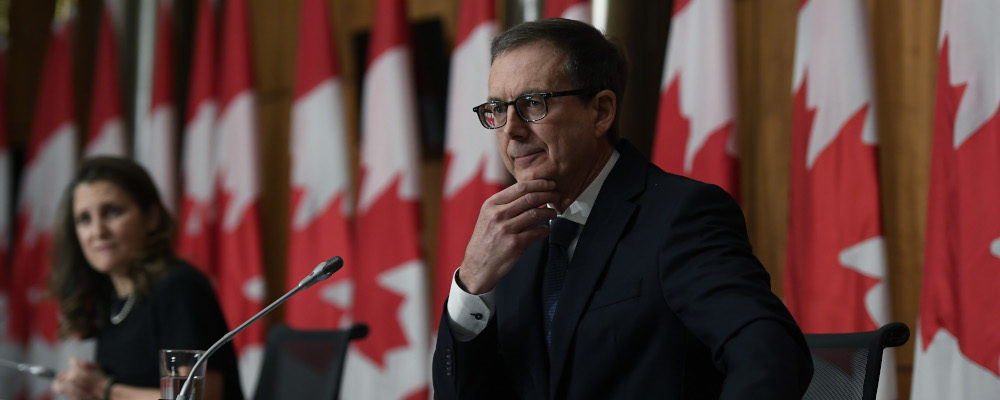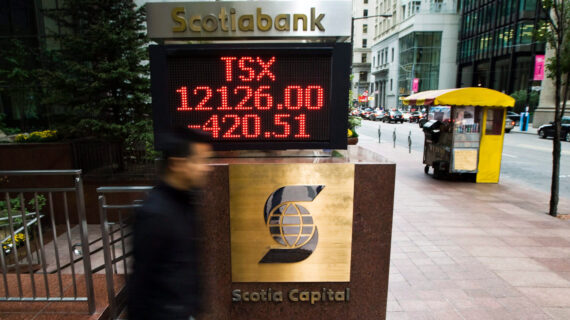Earlier this week the Government of Canada and the Bank of Canada issued their joint statement outlining the Bank’s mandate for the next five years. For those of us who follow the Bank’s policy actions closely, the statement was more than a little odd. Some might even think it contained some real problems and potential inconsistencies which will make the Bank less effective at its central task of keeping inflation low and stable.
Reading the statement carefully, I think there are two central points worth making. First, for anyone who really thinks carefully about the details of how central banks conduct their inflation-control policies, it is hard to avoid the conclusion that the renewed mandate will make no difference whatsoever to the Bank’s behaviour over the next five years. It will continue to conduct its policy as it has been doing, very successfully, since the early 1990s.
The second point, however, is that the joint statement reads almost as if it were written by two separate authors, ones that disagree about what the Bank should do and what the Bank is actually able to achieve, and that their compromise was for both views to be expressed, even at the cost that some contradictions appear. These are the parts which make the document a very odd read.
The best way to see all of this is to go through the statement part by part, which is what I do below. The statement begins with these three paragraphs:
The objective of Canada’s monetary policy is to promote the economic and financial well-being of Canadians. Experience has shown that the best way monetary policy can achieve this goal is by maintaining a low and stable inflation environment. Doing so supports a strong and inclusive labour market that provides every Canadian with opportunities for a good quality of life.
Currently, the reopening of the global economy is associated with elevated inflation in Canada and abroad. While this is a global phenomenon, it makes maintaining a sound framework for monetary policy in Canada all the more important.
From a longer-term perspective, since the adoption of an inflation-targeting framework 30 years ago, consumer price index (CPI) inflation has averaged close to 2 percent, despite periods of both upward and downward pressures on inflation. The maintenance of low, stable and predictable inflation has also contributed to Canada’s strong labour market performance. In the current context, Canada’s inflation-targeting framework helps to ensure that inflation will return to 2 percent over the medium term.
This is all good and pretty standard stuff. The second paragraph is, of course, unique to our current context, but hints at the general point that even though inflation is currently higher than normal in our recent history, this is no time to start changing the overall framework for monetary policy, which should be one chosen to work well through all kinds of economic situations. The two highlighted passages are making the point that the maintenance of low inflation is intimately connected with ensuring solid labour-market performance—a point that is obvious to genuine monetary policy specialists but perhaps is news to others; I say more about this point below.
The statement then enters some seriously odd territory.
The Government of Canada and the Bank of Canada believe that the best contribution of monetary policy to the well-being of Canadians is to continue to focus on price stability. The Government and the Bank also agree that monetary policy should continue to support maximum sustainable employment, recognizing that maximum sustainable employment is not directly measurable and is determined largely by non-monetary factors that can change through time. Further, the Government and the Bank agree that because well-anchored inflation expectations are critical to achieving both price stability and maximum sustainable employment, the primary objective of monetary policy is to maintain low, stable inflation over time.
The italicized passage uses words that are eerily close to the U.S. Federal Reserve’s “dual mandate” which requires the Fed to pursue both “price stability” and “maximum employment.” But the statement then quickly admits that this level of employment is not directly observable or measurable and, in any event, is determined mostly by things that cannot be controlled by the Bank of Canada. These are distinctly odd things to say when laying out a mandate for a central bank.
The statement invariably leads the reader (or at least this reader!) to wonder whether one party to the agreement (presumably the Department of Finance) insisted on mentioning the importance of maximum employment but the other party (presumably the Bank) went along only so long as the statement also made it crystal clear that it was practically impossible for the Bank to ever know whether maximum sustainable employment was ever achieved. And just in case the reader ever wonders which objective dominates in a situation where they might point the Bank in opposite policy directions, the next sentence makes it absolutely clear: the primary objective is low inflation.
So, at this point the statement has added some words about maximum sustainable employment which are odd but do not appear to tie the Bank’s hands at all in terms of its conduct of monetary policy. That much should be clear simply from the way the statement is written, quite apart from whether the reader knows anything about the details of monetary policy. It is even less worrying to specialists in monetary policy because of what is known among central-bank watchers as “the divine coincidence” of inflation targeting. In a nutshell, the divine coincidence is the idea that when central banks are using their policy tools to stabilize the rate of inflation around its target, they are also stabilizing employment around its full-employment level. This coincidence comes from the idea, based both in theory and in empirical evidence, that the pressures for inflation to rise or fall come directly from what is called the “output gap”, which is the difference between the actual level of real GDP and “potential GDP,” the economy’s productive capacity.
For example, it is when real GDP is above potential GDP (and employment is above its full-employment level) that inflation starts to rise. And it is when real GDP is below potential GDP (and employment is below its full-employment level) that inflation begins to fall. So, if the Bank of Canada is using its policy actions to keep inflation close to the 2-percent target, it is by those same actions working to keep employment close to its full-employment level. For this reason, most experts in monetary policy read the statement above and see, even if it wasn’t written so loosely, that it will not really change the behaviour of the Bank of Canada. In other words, the Bank of Canada is always supporting “maximum sustainable employment” when it is determining its policy actions, so there is really nothing new going on here.
The statement continues, however, by getting into distinctly unusual territory for a document laying out the job of the central bank.
This renewal of Canada’s monetary policy framework is occurring at a time when changes to the economy are complicating the task of monetary policy. The global financial crisis and COVID-19 pandemic have had a significant impact on the global economy and financial system, and major trends such as shifting demographics and new digital technologies are altering the economic landscape. Climate change and the long-term transition to net-zero greenhouse gas emissions will drive structural change in the Canadian and global economies. Also, there is now greater recognition, supported by economic research, that when the benefits of economic growth and opportunity are more evenly shared, it leads to more prosperity for the whole economy. A strong and inclusive labour market helps reduce income inequality and supports robust demand for goods and services.
All of this is true, and important. Financial crisis, global pandemic, shifting demographics (population aging), new technologies, climate change, and rising income inequality—they all have enormous implications for the Canadian economy and every other economy in the world. As a description of the complex world in which the Bank of Canada now finds itself, it is fine. But most of these things are far away from monetary policy, or at least they always have been, and for good reason. But maybe the future will be different. Is this just a preamble to a much-expanded mandate for the Bank? Here is what comes next.
Monetary policy is well equipped to address some of these challenges, less so for others. Two developments are particularly salient to the conduct of monetary policy:
• Neutral interest rates are likely to be lower than in the past, which means that central banks will have less room to lower their policy interest rates in the face of large adverse shocks to the economy.
• Major forces, including demographics, technological change, globalization, and shifts in the nature of work, are having profound effects on the Canadian labour market. These evolving forces have increased uncertainty about the level of maximum sustainable employment (i.e., the level of employment beyond which inflationary pressures arise).
The italicized sentence is the height of understatement, as no central bank has ever had access to policy instruments which can affect most of those challenges in any systematic and sustained manner. The one obvious exception is the central bank’s considerable ability to either prevent financial crises from occurring or to address them effectively once they have already occurred.
The two bullet points are very important for any central bank, but neither of them is new. The first is that for various reasons about demographics and the changing nature of technological change, the economy’s long-run equilibrium—or “neutral”—real interest rate is considerably lower today than it has been over the past few decades. The implication is that central banks’ policy interest rates will be closer to the “effective lower bound”, meaning that policy instruments such as quantitative easing are likely to be relied upon more in the future than was true in the past.
The second point is also important and takes us back to the idea that “maximum sustainable employment” is highly uncertain and is determined by factors outside the control of the central bank. As a bonus, the statement offers a definition of this concept, one fully consistent with how I described “full-employment” above: the level of employment above which inflation tends to rise (and below which it tends to fall).
To recap: the joint statement by the Government of Canada and the Bank of Canada mentions a bunch of economic issues that are important for all of us, but which the Bank can do little about. And then, almost as a non-sequitur, it tells us about two important things that central banks have known for a long time, the second of which explains to a large extent why most central banks do not have explicit and formal targets for employment. Keep this in mind for what follows. Here’s what’s next in the statement.
Consequently, the Government of Canada and the Bank of Canada agree to renew the inflation target on the following basis:
• The target will continue to be defined in terms of the 12-month rate of change in the total CPI.
• The inflation target will continue to be the 2 percent mid-point of the 1 to 3 percent inflation-control range.
• The agreement will run for another five-year period, ending December 31, 2026.
These are exactly the three fundamental aspects of the Bank’s previous mandate, and the one before that, and the one before that, and so on back to the mid-1990s. So, after all of the verbiage about maximum sustainable employment and strong and inclusive labour markets and a listing of important economic problems, the three key aspects of the Bank’s renewed mandate are completely unchanged. More than a little odd.
But there’s more.
The Government and the Bank further note that:
• Given that there is uncertainty about the maximum level of employment that is consistent with price stability, the Bank will continue to use the flexibility of the 1 to 3 percent control range to actively seek the maximum sustainable level of employment when conditions warrant.
• The Bank will consider a broad range of labour market indicators and will systematically report to Canadians on how labour market outcomes have factored into its monetary policy decisions.
• The Bank will also continue to leverage the flexibility of the 1 to 3 percent range to help address the challenges of structurally low interest rates by using a broad set of tools, including sometimes holding its policy interest rate at a low level for longer than usual.
• The Bank will utilize the flexibility of the 1 to 3 percent range only to an extent that is consistent with keeping medium-term inflation expectations well anchored at 2 percent.
• The Bank will explain when it is using the flexibility in the framework.
Let’s take these one at a time. The first bullet is nothing new and is a pretty fair description of what the Bank of Canada and other central banks have been doing for years. They have long known that their estimates of potential GDP and full employment are just that—estimates—and that a very careful examination of economic data is required to conduct the best monetary policy. On the second bullet, the Bank has also long known that labour markets are quite complex and that various indicators need to be monitored to figure out exactly what is going on, and why, and what it all means for the Bank’s policy. The clause about the Bank reporting to Canadians about how labour-market outcomes have been considered is interesting. The Bank already discusses these things in its quarterly Monetary Policy Report and also when the governor appears before parliamentary committees, but perhaps there will now be more emphasis placed on labour markets than before. In the name of transparency and having better explanations of monetary policy, this is probably a good thing.
The third and fourth bullets come together and reveal again the internal tension that appears to exist between the various parties that drafted the joint statement. The third bullet speaks to the flexibility inherent to the Bank’s inflation-targeting framework: following a shock of any kind, the Bank can use its judgment about how quickly it works to bring the rate of inflation back to its formal target of 2 percent. It also mentions a “broad” set of tools, even though the Bank’s collection of tools is not broad at all—they all represent slightly different (and connected) ways of using the Bank’s balance sheet. But the fourth bullet then clarifies that such flexibility will only be used if it can be done in such a way as to ensure that medium-term (2-3 years or so) inflation expectations remain anchored at 2 percent. Once again, the primacy of inflation control is reaffirmed.
Finally, the fifth bullet says that the Bank needs to explain how and why it is using this flexibility. Demanding that the Bank explain its actions is a very good idea, but this is something that the Bank already takes a great deal of effort to do on a regular basis.
The recap of these five bullet points is that there is a lot of printed words to cover ground that adds very little, and maybe nothing at all, to the way the Bank has conducted its policy over the past many years. For those people who think the Bank hasn’t been paying enough attention to labour-market outcomes in its policy decisions, these bullets may provide some comfort. But for those who understand how the Bank thinks about the sources of inflationary pressures and how inflation targeting works in practise, there is nothing new here.
The joint statement then heads into its concluding three paragraphs.
The Government and the Bank acknowledge that a low interest rate environment can be more prone to financial imbalances. In this context, the Government will continue to work with all relevant federal agencies to ensure that Canadian arrangements for financial regulation and supervision are fit-for-purpose and consider changes if and where appropriate.
Additionally, while monetary policy cannot directly tackle the threats posed by climate change, the Bank will develop the modelling tools needed to take into account the important implications of climate change on the Canadian economy and financial system.
Finally, recognizing the limits of monetary policy, the Government and the Bank also acknowledge their joint responsibility for achieving the inflation target and promoting maximum sustainable employment.
The first paragraph reaffirms the importance of the Bank continuing to work with other agencies to ensure financial stability. This is obviously good, but if it hadn’t been said in this joint statement would anyone now expect the Bank to start ignoring this issue or to discontinue its consultations with the other agencies?
The next paragraph contains the second mention of climate change in the document. This issue has been cropping up in many countries and in many discussions about the potential role of central banks. Since the Bank cannot implement carbon prices or environmental regulations or support research and development of clean technologies, it is very good to see a clear and frank admission that the Bank cannot directly address this challenge. This admission will hopefully inoculate the Bank from pressure that it may be under from various sources to “act” on climate change. And it is also good for the statement to clarify that the Bank will conduct the necessary modelling to determine the effects of climate change on various aspects of the economy—prices, wages, potential GDP, economic growth, etc. The Bank obviously needs to consider how climate change makes its job more complicated, although several speeches from the Bank over the past few years prove that the Bank was already thinking seriously along these lines.
The statement’s last paragraph is one of the most intriguing. One could read this paragraph as affirming that inflation control (and the associated aim for full employment) is obviously a joint responsibility between the Bank and the Government—for the simple reason that the Bank is ultimately responsible to the Government and thus anything that the Bank does is part of what the Government does. In this case, there is nothing of real interest in the paragraph.
Alternatively, one could read the paragraph as acknowledging the need for more subtle “policy coordination” between the monetary and fiscal policy to maintain low inflation and maximum sustainable employment. Such policy coordination is also not new, and there is usually plenty of communication between the two entities, but in this reading one is led to wonder what precise message is being sent by this paragraph. Unfortunately, no answer is provided.
Wrapping all of this up, what should we make of the latest joint statement by the government and the Bank? Unfortunately, it is more difficult than usual to discern the real message.
On the one hand, one can certainly find a collection of passages which, taken together, make it clear that the Bank will continue with its established practice of inflation targeting, working to keep inflation relatively stable around a target of 2 percent, and doing so in a way which provides flexibility in the face of major economic shocks. If this is how consumers and workers and businesses and financial-market participants interpret the statement, then all is well. There would be no reason to expect any change in the Bank’s serious commitment to low inflation, and inflation expectations as a result will remain well-anchored at or near 2 percent.
But the statement can clearly be read differently. With the various mentions of maximum sustainable employment, income inequality, inclusive labour-market outcomes, and climate change—which have not appeared in previous joint statements dating back to 1991—it is very tempting to conclude that the tensions I considered above were very present during the drafting process. Despite protestations from Finance Minister Chrystia Freeland and Governor Tiff Macklem in their press conference that they are completely aligned, maybe the truth is that they disagree about the Bank’s limitations and about how it should be conducting policy. Maybe that is why the joint statement is so much longer than previous ones, with those various other topics mentioned. Maybe their inclusion was insisted upon by the minister as an explicit “shot across the bow” of the Bank, a warning that if it does not change its ways then the government may be prepared to interfere.
If this is what is really going on, then all of us should be worried about the future. If the Government is not really committed to having an operationally independent Bank of Canada pursuing low and stable inflation, then there is good reason to expect that inflation and inflation expectations may become unanchored.
Canadians do not want, and will not benefit from, a return to higher and more volatile inflation. Unfortunately, the latest joint statement from the Bank and the Government may have signalled just such a future.




